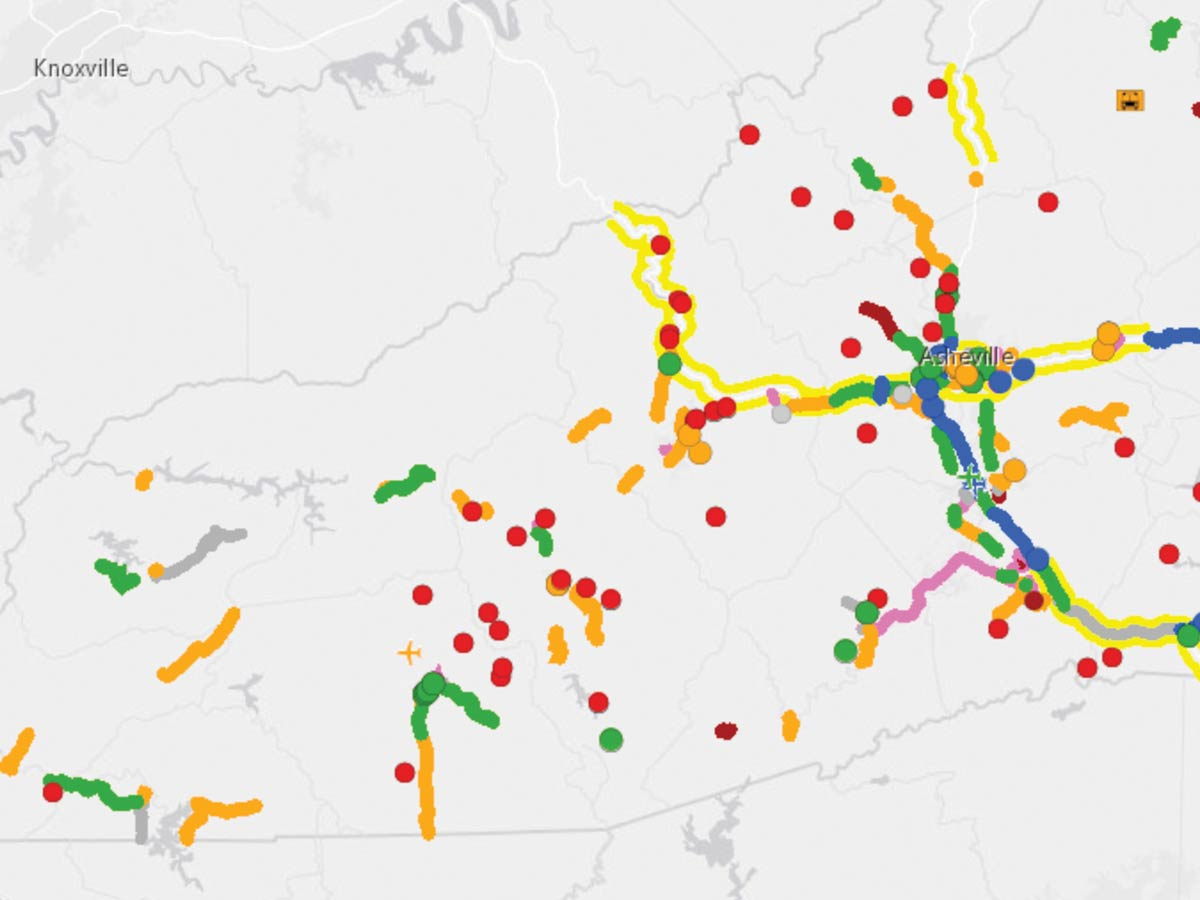Growing pains: region reckons with development
 The region’s growth is reflected in the NCDOT’s 2020-2029 STIP project map. NCDOT photo
The region’s growth is reflected in the NCDOT’s 2020-2029 STIP project map. NCDOT photo
Western North Carolina is growing, there’s no doubt about it. And as it does, there are bound to be growing pains.
“I can only theorize, but it did seem like despite the pandemic or because of the pandemic, we started to see a surge in real estate transactions, both on a large scale and small scale, and it’s not just been Waynesville — it’s been Haywood County, Western North Carolina, and a lot of the Southeast,” said Elizabeth Teague, development services director for the Town of Waynesville.
Teague’s been with the town for seven years now, since right about the time the region started to turn the corner on the Great Recession of 2008. As such, she’s witnessed the resurgence of development that for a time had stagnated.
Now, unprecedented regional growth is fueling plenty of painful, unintended consequences.
According to Canopy MLS, the realtor cooperative used by many WNC realtors (Burke, Buncombe, Haywood, Henderson, Jackson, Madison, McDowell, Mitchell, Polk, Rutherford, Swain, Transylvania and Yancey counties) 2021 home sales were up 11.8% over 2020. New listings in December were down 8.9% year-over-year, and the 2021 average sales price of $417,969 was an 18.3% increase over 2020.
Haywood County’s median sales price in 2021 was $311,000, while the median income was $27,234.
Related Items
While the sales data may be good news for Realtors, it’s also making it so much harder for the regional workforce to find places to live that Haywood County recently adjusted its economic development goals to put more of an emphasis on workforce housing.
“We have been talking really over the last five to seven years about the importance of maintaining variability in our housing markets so that we can meet all needs, and that’s becoming more and more challenging,” Teague said.
The prices are very alluring to landowners eyeing unused portions of their parcels, looking for a payday. It’s not just small parcels, either.
“Certainly, we’re seeing pieces of property that have sat undeveloped for a long time enter the market,” said Teague.
The biggest, and best known of late is what’s called the Queen’s farm property, off Sunnyside Street. Soon, it will be home to four houses per acre — a total of 115 units — at around $400,000 each. The development encountered stiff resistance when first brought before the planning board last September.
“That was a shock,” Teague said. “When you have a piece of beautiful farmland that has sat there forever and all of a sudden it’s in front of the planning board, that’s a shock to people.”
Although housing inventory is needed at almost all price points, the development also comes with drawbacks of its own.
“As you increase development and lots that were once empty or not as dense become developed and more dense, the roadway system will end up seeing an impact,” said Teague.
Indeed, one of the concerns surrounding the Queen’s farm project was how 115 households with one or two cars each would impact traffic on Sunnyside.
“We let DOT know of our concerns because that happens to be a state road and it was a very small farming road,” Teague said. “We still have some concerns about the amount of traffic going out onto that road, and we are actually working with J.M. Teague [a local engineering and planning firm] to revise our threshold for traffic impact analysis.”
Transportation infrastructure issues aren’t localized to the development on Sunnyside. In fact, growth over the past decade prompted a number of high-profile road projects across the county.
“In Waynesville, we had three big DOT projects, Russ Avenue, South Main, and North Main,” said Teague. “Russ Avenue used to be the first one coming out, then it was gonna be South Main and then it was gonna be North Main.”
The Coronavirus Pandemic slowed progress on all three projects, as did DOT mismanagement resulting in overspending of more than $740 million.
“The North Main project is a little smaller, so I think they’re going to start with that,” Teague said. “Everything’s been pushed back a little bit.”
The North Main project — a new roundabout near the Water’n Hole — is scheduled for completion this year.
The Russ Avenue project, running from Walnut Street to the Great Smoky Mountains Expressway, was supposed to begin construction in 2020, but the DOT’s website hasn’t been updated since late 2019 and shows no update.
The South Main project is scheduled for right-of-way acquisition in 2024, with construction to begin in 2027.
But the greatest pains will be felt thanks to a bridge replacement project in the heart of the county, which is scheduled to begin this year.
“The biggest impact traffic-wise of a project is going to be the bridge replacement on the expressway, which will send detours through Waynesville,” Teague said. “We asked DOT about it like, ‘Wait a minute, if you start this project, and then you start the Russ Avenue project, and North Main at the time, which is where you’re sending people on detours, then it will be a mess.”
Even the pandemic couldn’t stop growth in Haywood County, but in looking to 2022, Teague sees at least some possibility that it could slow, even if only slightly.
“I think there’s a lot of factors,” she said. “One thing that fueled the fire of development was low interest rates and that’s changing. That might slow the rate at which people think they can get mortgages. In the development community that has a big impact. We’re also noticing that the big pieces of property that are open — the Queen farm is fairly flat for this area — get purchased and people start making plans, so what’s left is fairly steep property, which is more expensive to develop. In that respect, as the inventory has changed, we might see a slowdown because there’s just not as much available land.”
COVID, supply chain issues slow projects
Two substantial housing developments in Waynesville are both behind schedule, thanks to delays associated with the Coronavirus Pandemic and lingering supply chain issues. The historic Haywood Hospital, home to about 50 1- and 2-bedroom affordable housing units for verterans and the elderly, should have been open already, according to County Manager Bryant Morehead. The former Bi-Lo on Russ Avenue, which will become more than 200 apartments, is still in the site work phase of construction, said Waynesville Development Services Director Elizabeth Teague.









